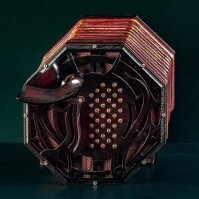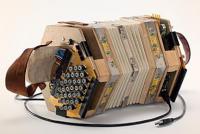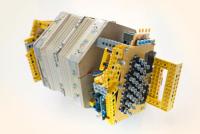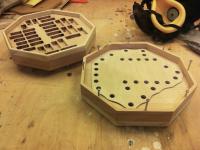-
Posts
656 -
Joined
-
Last visited
Everything posted by Łukasz Martynowicz
-
@Don: Yes. But if you want just bellows pressure information you can combine pressures from each cylinders into a single sensor. Of course if you want to improve the concertina controller to be more than just an electronic version of acoustic instrument, you could use this additional information as MIDI controls. I think that this corded version I posted previously uses each cord as a separate MIDI X/Y control in addition to bellows movement information. One drawback with using air cylinders would be relatively small travel, perhaps equal to three fold bellows (assuming the most ergonomic size of entire instrument)... And I agree with Matthew on Charles Wheatstone, I think that he would be first to push boundaries further. After seeing some of his patents on advanced mechanical reeds (e.g. re-tunable reeds) I think that he might even electrify concertina (as in electric guitar, not MIDI controller).
-
The solo use of RPi might be tricky, as it is a computer not a microcontroller, so it has no ecosystem for connecting raw electronics to it. I have an old Arduino Duemilanove http://arduino.cc/en/Main/arduinoBoardDuemilanove#.UyTK01w4NGJ . If I were to build completely new instrument now, I would probably aim at Arduino Yun or Tre http://arduino.cc/en/Main/ArduinoBoardTre#.UyTJ1lw4NGI , http://arduino.cc/en/Main/ArduinoBoardYun#.UyTJxlw4NGI , depending on what exactly can you run on Yun Linux implementation. This way I would probably try to build a self containing instrument with optional MIDI capabilities. Yet, right now I'm aiming at home studio use and not full-blown stage/gig applications, so connecting pure Arduino via USB and then work on software MIDI is the best option for me. I could just use a laptop as a synthetizer if I ever need to play elsewhere.
-

Midi Hayden Duet? Assessing Demand
Łukasz Martynowicz replied to MatthewVanitas's topic in General Concertina Discussion
There is one problem with iDevices - you have to build a true standalone MIDI controller based on Arduino (or any other microcontroller), which sends MIDI messages over a MIDI cable and this is a lot of computation for Arduino (and my board had too few inputs and outputs to make that happened). The reason for that, is that iDevices require deviceID for anything other than MIDI accesories and this is not easily obtainable. At least that's how it was three years ago, this could have changed. That is why I wrote about Android devices, which have no such limitation. But yes, a smartphone as a "brain" for such concertina is probably the most versatile solution. But it is a path towards commercial production, not a single, DIY controller. In my concertina Arduino serves only as a gatherer for different values, which it then sends in raw form to Processing driver running on host system. The reason for that is that Processing has some neat MIDI libraries, Arduino does not. This requires a host capable of running my code and support for a software MIDI device. Back then that was true for OSX, Linux and Windows. -

Midi Hayden Duet? Assessing Demand
Łukasz Martynowicz replied to MatthewVanitas's topic in General Concertina Discussion
Thank you Inventor. On some point of my initial research I did consider building an instrument like you described, self-contained with loudspeakers, as prices of large acoustic Haydens are enormous (justified, but enormous still). But there are some problems with this approach: you will have to fit a full-blown midi-synthetizer and speakers inside, or make it based on android smartphone for "brains", or use something like Raspbery Pi computer-on-board, or find a way of generating an acceptable sound in an analogue form. And then there is a problem of loudnes of portable speakers and their response characteristics, designing proper acoustic chambers for bass amplification etc.. It is a far greater deal than a relatively simple MIDI controller, so I've abandoned this path very early. One more idea that cames to mind, is to build something with a principle similiar to electric guitar, to be able to plug such concertina to all sorts of guitar effects, but I don't realy have any sensible idea on how to bite this one... -

Midi Hayden Duet? Assessing Demand
Łukasz Martynowicz replied to MatthewVanitas's topic in General Concertina Discussion
After your post Jim, I was courious on what exact movements S-Wave concertina supports and it seems that… none at all. So it looks like there is just a milimeters worth (if any) movement of the sides and the only information this concertina gets is the force between ends. So it would probably be impossible to use any vibrato or other vigorous bellows effects. This instrument had previously it's own thread here: http://www.concertina.net/forums/index.php?showtopic=10197 -

Midi Hayden Duet? Assessing Demand
Łukasz Martynowicz replied to MatthewVanitas's topic in General Concertina Discussion
I just found a very interesting construction, I especially recommend the video: http://crewdson.net It is a variation on mechanical aproach - look here for description: http://en.wikipedia.org/wiki/Gametrak. It has a clear benefit of enormous extension and complete compression, so movement of the ends is completely unrestricted. it wouldn't feel much real though, because the force on the ends always points to the outsides. -

Midi Hayden Duet? Assessing Demand
Łukasz Martynowicz replied to MatthewVanitas's topic in General Concertina Discussion
@Jim: My bad. I'm not a native english speaker and sometimes I translate polish idiomatic phrases or polish grammar straight to english which changes or clouds the meaning. I meant that a common practice (from what I saw in various videos) is to held an english on a lap and work the bellows like a fan, which can be aided by attaching a strap to bottom ends. And this is just a side note, as I was describing the reason why S-Wave MIDI english can use only one air piston and not debating on english concertina playing techniques. -

Midi Hayden Duet? Assessing Demand
Łukasz Martynowicz replied to MatthewVanitas's topic in General Concertina Discussion
Yes, a tube with a piston. If you mount three of them to concertina ends in such way, that mounting points form a triangle, you will have a dynamic response with every possible end movement. S-wave solution is good (natural) for englishes only, which are often played with bottom edges of the sides connected with a strap. -

Midi Hayden Duet? Assessing Demand
Łukasz Martynowicz replied to MatthewVanitas's topic in General Concertina Discussion
Three hinged cylinders will allow same degree of freedom - they will only not bend around the leg in the same fasion, but relative movements of concertina ends can be the same as the real thing. -

Midi Hayden Duet? Assessing Demand
Łukasz Martynowicz replied to MatthewVanitas's topic in General Concertina Discussion
@Dave: that may work well, depending on what tolerances and resolution of those devices are available. Another way may be to put a simple linear potentiometer between the sides and work with that. But in each case (air cylinders, potentiometers and ultrasound/laser ragefinders) you will need three of them to measure all possible relative movements of concertina ends. Using bellows pressure gives you such an information already embedded in the readout. -

Midi Hayden Duet? Assessing Demand
Łukasz Martynowicz replied to MatthewVanitas's topic in General Concertina Discussion
@Don: Yes, it is completely pressure sensitive, with four different response curves available. It can do vibrato, it was bisonoric for at least a while and covers full range of MIDI volume (or velocity) levels. You can use it for realistic software bellows, string and woodwind instruments. But as I wrote before, the main problem I had is the low pressure in the bellows and thus a poor resolution of readouts - this have tremendous effect for all bellows driven effects, they are there, but sometimes sound very harsh, especially on low volume/bellows direction change. I have sensors with the lowest range of measurement I could find and I could only make them response in about 1/4 of available range. This is probably the reason why s-wave uses air cylinders instead of a bellows. I have recently done some quick tests using LEGO cylinders, and I could easily use the full range of values with them. I'm considering similiar approach to be able to disconnect the ends of such instrument and convert it to a flat keyboard with velocity sensitivity when desired. -

Midi Hayden Duet? Assessing Demand
Łukasz Martynowicz replied to MatthewVanitas's topic in General Concertina Discussion
Well, I have mentioned it a couple of times in various places around this forum, but since you have made a specific topic on this subject I think it won't hurt to put some more detail on my DIY MIDI project. I was playing on a cheap German Anglo then, and wanted to be sure if I wanted to switch systems, as bisonoric bellows control is so much fun (this is something I really miss sometimes). The whole thing has costed me something around 200$ [including new soldering iron and Arduino board]. It is a 64 button (Wakker H2 layout), pressure sensitive instrument, with transposition knob and four aditional switches, based on Arduino board and Processing language and, because of this, it is an USB controller. It requires a "driver" running on target system. I have chosen this approach mostly because I don't have any other midi equipment and I would need a MIDI-USB adapter anyway. Some pics of working prototype: 1. Fast LEGO prototype used for writing the driver: 2. final, working prototype. I have used it for about 8 months before I bought Elise. Back then, due to some bugs in the software it had to be restarted every 10-15 minutes as it was developing an increasing lag. I have abandoned this project after buing Elise, but revised it recently when I was in need of midi keyboard for composing. Now it has no lag and I will probably make it a decent MIDI instrument some day - haven't decided yet if in concertina form or a planar keyboard with some sort of pressure/wind/velocity controll. In present form it can act as a concertina (pressure controls volume) or a piano (pressure controls velocity). It has a functional air button, so bellows controll is same as the real thing. It doesn't send "all notes off" on bellows direction change, instead there is a pressure offset below which all notes are silent. Unfortunately, I had to guess pressure levels inside the bellows when I was buing sensors, so I had to struggle with very low resolution of readouts. This is one of those things I'll have to rethink before building a final version. Side note: the first driver also allowed me to run this instrument in "AngloHayden" bisonoric mode, with definable interval between push and pull notes. It was fun, but I "fell in love" in Hayden layout in mater of days, so I scrapped the switches for some other parameters (as I have written above, it only has 4 parameter switches and I wanted to controll as much as I could via hardware). Because I was doing the whole thing as cheap as I could, I have used pre-drilled universal boards for keyboards, so spaces between buttons are slightly different than in Brian's specifcation. A simple demonstration of this instrument (well, a driver at least) in play: http://www.youtube.com/watch?v=X0buNZcKxHc This was the first tune I learned on Hayden layout more than 3 years ago, so it's realy basic. I designed a driver to be a learnng aid - as you can see it shows note names (with transposition) and pressed buttons in real time. -

Concertinists: Are We Stuck In Ruts?
Łukasz Martynowicz replied to Jim Besser's topic in General Concertina Discussion
Taking this thread back to OP question, here are my two cents: Yes, I think that concertina community is stuck in ruts, they are just wider and may not be obvious at a first glance. I'll take Jody's list as an ilustration to my point (nothing personal Jody, it is just great example): What is the common denominator of almost everything on this list? It is public domain and decades or even centuries old (I know that Jody and some other players here write their own music sometimes, but usually within a well established, traditional genre). We as humans tend to look at smaller and smaller details as we specialize in something, be it art, science or our musical taste. Trad player will see a huge difference between Breton, Morris or Scandinavian folk, but for someone with entirely different taste or musical background it is all FOLK. In other words - playing scandinavian folk might be "out of the rut" for an english player, Breton may be something new for an american Blue Grass player, but it is still going in circles... OP question was asked in comparison to a melodeon - just another folk instrument, with comparable historical applications. So why not compare with an accordion, which is, no doubt, the most succesfull of all squeezeboxes? And IMHO it is not because it's musical attributes, but because accordionists have adapted to virtually any genre, they are, as a whole, definately not stuck in any ruts. They are folk accordionists, punk accordionists, folkmetal, classic, jazz, pop, disco, experimental, indie, and so on. You name it and there is someone who at least tries to play it on an accordion. Why don't we have something like e.g Dropkick Murphys with a concerina, only acoustic folk bands or purely squezebox ensembles? With amplified music there is really no argument, that concertina is too weak or to quiet. And why there is no one (at least no one I know) who experments with "electryfiyng" a concerina (e.g with vocal pedal effects)? "Our own" Thomas Restoin have posted a cover of Daft Punk today in another thread (https://soundcloud.c...n-1/get-lucky-8) and this is the most "out of the rut" piece I've heard on this forum since I've joined. It may be outside of musical taste of any of us, but it is definately pushing boundaries. And IMHO all that Thomas is doing on his duet is a great example of at least widening the ruts if not entirely geting out of them. I think that Marc G. Lamb may be right: But is it bad or good to be stuck in ruts is a completely different matter, and this will heavily depend on personal view, and I have no intention to judge that. We just might try to be a little bit more tolerant within our small community. Take a Dirge "taking a break" for example, after his duet was called "a cumbersome heavy tanker" by an Anglo player. Isn't our main goal as players of almost forgotten instrument to spread concertina music in any form and encourage anyone interested in playing it? Regardles of what system and what genres he wants to play? -
I'm assuming that by pop songs you mean anything modern in character Pop/rock covers are my main repertoire and the sole reason why I chose Hayden over an Anglo, so my full list of links would be rather long. I don't have enough time on my hands recently to record anything new, but some of those I have practiced long enough to record as soon as the opportunity arises: http://www.youtube.com/watch?v=kfH1hxvAN30 "Jest super" by T.Love, this is a sad song about polish reality, which is true even after 20 years after original release. It is interesting enough to play on concertina, mostly because of 3-4 different parts, with some interesting solo http://www.youtube.com/watch?v=gvDKuRP8vRE "Czarny chleb i czarna kawa" by Strachy Na Lachy - a punk rock song about a convict traveling to a prison. A simple piece, consisting almost entirely of one progression, but the intermission on harmonica adds a nice flavour to it, and played with double chords (6 reeds speaking at once for a large portion of the song) gives it enough power to sound like a true concertina punk. http://www.youtube.com/watch?v=DqBuIaa2-_s "Baranek" by Kult - this have an interesting story, because it is a song from 1960, performed by a son of a composer - it became probably the most popular, cult song of entire generations (two already). It has a very nice solo on a french horn and accordion, which sounds great on a concertina. It have proven for me, that songs with a brass section in them are an ideal material for a duet concertina. http://www.youtube.com/watch?v=Cdjm-PiiDPw "Dwie panny w jednych spodniach" by Disparates. It is very straightforward, as it has accordion in it, but the chorus is quite chalenging because of the tempo of arpeggios. This is an excerpt only, I have about 1h of rock/punk/indie repertoire now, but I'm only begining to feel confident with singing to my own accompaniment.
-

Sounds Like A Concertina ?
Łukasz Martynowicz replied to Geoff Wooff's topic in Instrument Construction & Repair
Thank you for your answer Frank, that sums it up for me. -

Identifying Appropriate Chords
Łukasz Martynowicz replied to Hillsider's topic in Teaching and Learning
Most folks here will probably see it as another Wicki-Hayden keyboards fanboy post, but there is a very straightforward method for learning harmony and identyfiying chords needed. Because in W-H system, major and minor scales are closed clusters of buttons, every chord that can be contained within such cluster is a native chord for particular key. You don't realy need to learn this layout, just treat it as a shortcut tool: 1. print out a layout of a full Wicki-Hayden keyboard (http://upload.wikimedia.org/wikipedia/commons/thumb/e/e8/Wicki-Hayden_Musical_Note_Layout.png/400px-Wicki-Hayden_Musical_Note_Layout.png) 2. get a glance on this page: http://www.shiverware.com/musix/wicki/chords.html - it shows EVERY chord layout on this keyboard. For those unfamiliar with this layout, chords have constant shapes, regardles of key. 3. connect the notes of your melody with a line to form a graph, an then look at how the music wanders around a keyboard and fit chords that will have something in common with a melody (a note, a direction of movement etc..) 4. look at those common progressions: http://idiotsguides.com/static/quickguides/musicperformingarts/common-chord-progressions.html and check if anything fits on your melody line. 5. experiment with inversions etc to make harmony more interesting This is not a complete theory of course and an experienced player will find better harmonies just by ear, but IMHO this is a good tool for a beginner. -

Sounds Like A Concertina ?
Łukasz Martynowicz replied to Geoff Wooff's topic in Instrument Construction & Repair
One other way to put it: is it possible to build even a simple, experimental, proof-of-concept, single note instrument, that will sound like a genuine concertina, but will have an accordion reed? -

Sounds Like A Concertina ?
Łukasz Martynowicz replied to Geoff Wooff's topic in Instrument Construction & Repair
@Frank: what I meant was not to neglect those other factors, I know that many different things affect the final outcome to some degree. Maybe I'll rephrase my thought: what the resulting sound would be, if you have replaced the reed in this experiment you have described with a cut-to-fit accordion reed? The same concertina, same wood thickness and density, same chamber sizes, just a different shape of the tongue, accordion vs concertina style? Would it be a drastic change of tone? -

Sounds Like A Concertina ?
Łukasz Martynowicz replied to Geoff Wooff's topic in Instrument Construction & Repair
Very interesting. That could lead to a conclusion, that the main (if not only) factor defining a tone of a free reed instrument is the physics of a vibrating tongue - different for parallel tongues in tapered frames vs tapered tongues in parallel frames. One other thing, that may be responsible for difference in the tone of Wakker concertina reeds is that they are produced in a modern CNC way, not with traditional methods. Hand manufacturing of anything gives a less-perfect, "warmer" touch to anything, be it furniture, casted or milled metal works, woodworking, sculpting etc. because of minute deviations from ideal shapes, lower tolerances, slight mistakes and so on. Might as well affect the tone of a reed. -
In the first place, you should consider your desired repertoire: I've starded on an Anglo just to discover, that while this is a compact instrument with a lot of tradition and a great fun, I could not play almost anything I wanted on it, because of its bisonoric nature. Each type of concertina has its limits and benefits. You should also consider how steep the learning curves for each type are and how much time you'll be willing to spend on playing. E.g.: it is very easy to play a melody in a home key of an Anglo, but it gets a lot harder if you want to play in different keys with a lot of harmony; it's very easy to play harmony on a Hayden and you benefit from learning in almost all keys at once, but playing melody is sometimes more demanding; englishes are more logical than Anglos (outside the home keys), but the alternating hands style of play may not suit everyone and ergonomics may be awkward if you have long fingers or any problems with your wrists; and so on... Read all discusions here regarding advantages and disadvantages of Anglos, Englishes, Haydens, Maccans, etc… and then try as much different types as you can. The more informed decision you'll make now, the smaller is the chance that you'll want to change your choice after a year or two. And Concertina Connection starter models are perfect for the first instrument as they may be traded in when upgrading both with Concertina Connection and ButtonBox. One last thing: there are a lot more Anglo players on YT than all other types together, so the impression from watching YT might be a little biased. Listen to some great examples of different possibilities in this thread: http://www.concertina.net/forums/index.php?showtopic=16240 or TOTMs, where you can compare the same tune played in different styles on different concertinas. Listen both to the best players around like Jody Kruskal or Thomas Restoin and those with just couple of years of experience, to see (hear) what they struggle the most with.
-

Building Hayden Duett
Łukasz Martynowicz replied to Łukasz Martynowicz's topic in Instrument Construction & Repair
Thanks, such words from a professional concertina maker are most encouraging- 78 replies
-
- Construction
- Building
-
(and 2 more)
Tagged with:
-
Great one Thomas! And it's nice to finally see you playing. I must say, that your playing is the best example of what duets are capable of in hands of a skilled player! Side note: I knew that you're playing Dipper custom, but I did'n knew that it has asymetric ends. Is the bass side thicker because it has two reedpans in two layers?
-

Building Hayden Duett
Łukasz Martynowicz replied to Łukasz Martynowicz's topic in Instrument Construction & Repair
Ok, so here is the final photo of this weeks progress, both reedpans have been fited and everything can now be assembled together.- 78 replies
-
- Construction
- Building
-
(and 2 more)
Tagged with:




